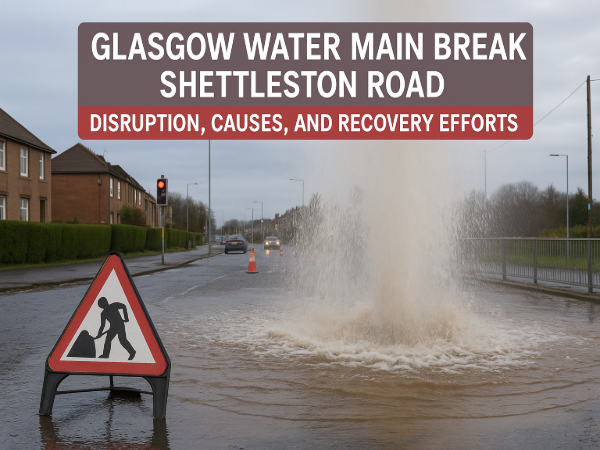Glasgow Water Main Break Shettleston Road: Disruption, Causes, and Recovery Efforts
A Major Incident That Shook Glasgow’s East End

The Glasgow water main break Shettleston Road has caused significant disruption for both residents and commuters, highlighting the serious challenges of aging infrastructure in urban areas. The burst main led to widespread water outages, road closures, and traffic congestion, forcing authorities to act quickly to restore essential services. Incidents like this emphasize the need for preventive measures, timely maintenance, and effective emergency response strategies to ensure public safety and minimize future disruptions.
Understanding the Glasgow Water Main Break on Shettleston Road
Water main breaks are not uncommon in large cities, but when they occur in densely populated areas such as Glasgow’s East End, the impact can be far-reaching. The Shettleston Road incident disrupted everyday life, leaving many residents without water, commuters stranded in long queues, and businesses struggling to continue operations.
Authorities confirmed that the break originated in a major pipeline running beneath Shettleston Road, one of the busiest routes in the city. The rupture caused a sudden loss of water pressure, flooding sections of the road, and forcing closures in both directions. For local households, this meant taps running dry, while for drivers, it meant lengthy diversions and delays.
The Immediate Impact on Residents
One of the most noticeable effects of the Shettleston Road burst was the water outage that hit hundreds of homes. Families in the G32 area reported low pressure, intermittent supply, or no water at all. Others faced discoloured water — often brown due to sediment stirred up in the pipes, or cloudy from trapped air.
Such disruptions extend beyond inconvenience. Without water, residents face difficulties in cooking, cleaning, and maintaining hygiene. Vulnerable groups, such as the elderly or families with young children, are particularly affected when outages last for several hours or longer. Scottish households rely on a consistent supply of clean water, and interruptions quickly highlight how vital this service is in daily life.
Traffic Chaos and Road Closures
Shettleston Road is a central artery for commuters in Glasgow’s East End. When the water main burst, sections of the road were closed from Old Shettleston Road to Fernan Street, and further diversions spread to nearby routes like Westmuir Street. This caused severe congestion during peak travel hours.
Commuters reported journey times doubling, while public transport faced reroutes and delays. Businesses along the road also saw fewer customers due to restricted access. The road closure not only highlighted the disruption caused by the burst itself but also the ripple effect on mobility, commerce, and city logistics.
Why Do Water Mains Break?
Water mains typically fail due to a combination of factors, many of which stem from aging infrastructure. In Glasgow, as in many historic cities, sections of the water supply system are decades old. Over time, these pipes can deteriorate, crack, or corrode. Other contributing factors include:
Temperature fluctuations: Sudden freezes and thaws can expand or contract pipes.
Pressure changes: High water demand or sudden pressure shifts can stress weakened mains.
Ground movement: Heavy traffic, nearby construction, or natural shifts can destabilize buried infrastructure.
Material fatigue: Older pipes made from outdated materials are more prone to failure.
The Shettleston Road incident is not isolated; it is part of a wider pattern where urban water systems struggle under the weight of time, population growth, and increased demand.
Response from Authorities
Scottish Water teams responded quickly once the burst was reported. Crews arrived at the scene to isolate the damaged section, reroute supply through nearby valves, and begin repairs. Engineers worked to minimize disruption by restoring water to as many households as possible while keeping safety at the forefront.
Traffic management teams were deployed to control the road closures and ensure safe access for repair crews. Authorities also issued public guidance:
Run the cold kitchen tap slowly if water is brown until it clears.
Avoid using hot water or appliances until the supply stabilizes.
Allow cloudy water (caused by air) to settle, as it usually clears within 24–48 hours.
These measures helped residents cope with the disruption while the repair process unfolded.
The Economic and Social Cost
The Glasgow water main break Shettleston Road carried both economic and social costs. Local businesses such as cafés, shops, and small service providers faced sudden interruptions. Without running water, many food-related businesses could not safely operate. Reduced foot traffic due to road closures further compounded losses.
On a social level, the incident caused frustration and stress for families. Parents struggled to manage without a reliable water supply, while workers and students faced commuting delays. For many, the disruption served as a reminder of how dependent modern life is on unseen infrastructure operating smoothly.
Community Reactions
Local residents voiced their concerns on social media and in community forums. While many appreciated the quick response from Scottish Water, others expressed frustration at the inconvenience. Some raised questions about why such bursts occur so frequently in Glasgow and whether enough investment is being made into upgrading old systems.
Community resilience was also evident. Neighbours shared bottled water, offered use of facilities, and helped elderly residents cope with the disruption. Such responses highlight the strength of local communities in times of crisis, even as they call for more reliable long-term solutions.
Lessons from the Shettleston Road Incident
Every water main break provides lessons for urban planners, city councils, and utility providers. Key takeaways from this incident include:
Infrastructure investment is urgent. Older water systems need replacement before failures occur.
Preventive monitoring helps. Advanced sensors and smart meters can detect stress points before a rupture.
Communication matters. Clear, timely updates help residents cope with uncertainty.
Emergency planning is essential. Quick deployment of crews and traffic management reduces overall disruption.
By applying these lessons, Glasgow — and other cities facing similar issues — can strengthen resilience against future incidents.
Looking Ahead: Preventing Future Water Main Breaks
The Shettleston Road event has reignited discussions about Scotland’s aging water infrastructure. Authorities must balance immediate repairs with long-term modernization. Potential strategies include:
Pipe replacement programs targeting high-risk areas.
Technology adoption such as AI-driven monitoring and predictive maintenance.
Increased funding from both government and utilities for proactive infrastructure upgrades.
Public awareness campaigns to educate residents on water conservation and what to do during outages.
These preventive steps will not only reduce the frequency of such bursts but also ensure that when they do occur, the response is faster and less disruptive.
Conclusion
The Glasgow water main break Shettleston Road serves as both a disruption and a warning. It disrupted daily routines, halted traffic, and tested the resilience of residents and services. More importantly, it shed light on the vulnerabilities of aging infrastructure in a growing city.
Authorities acted swiftly to restore services, but the long-term solution lies in sustained investment, modern technology, and proactive planning. For residents, the incident was a reminder of how vital clean water and reliable infrastructure are to everyday life. For policymakers, it was a call to prioritize resilience and readiness in the face of inevitable challenges.
Glasgow’s East End will recover from this incident, but the lessons it leaves behind must guide future action — ensuring that the next burst water main causes less disruption and greater confidence in the city’s infrastructure.



